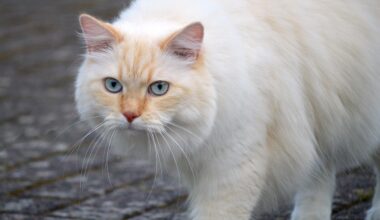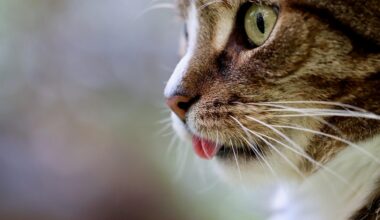How to Transition Your Cat to a Dental Diet
Transitioning your cat to a dental diet is vital for maintaining optimal oral health. Ensuring good dental hygiene in cats can prevent serious health problems, such as periodontal disease. A dental diet is specially formulated to reduce plaque and tartar buildup and promote healthier gums. The first step in this transition is to consult with your veterinarian. Your vet will recommend the best dental diet for your cat’s unique needs. You can find many options in the market, but not all are created equal. Once you have the right food, introduce it gradually by mixing it with their current diet. Start with a small ratio of dental food, substituting about 10% of their usual food. Observe your cat’s reaction and their willingness to eat the new diet. Continue to increase the proportion of dental food gradually over a week or two. This method helps your cat adjust and also allows you to monitor for any digestive issues. Stay patient during the transition; every cat is different and can take time to adapt to new textures or flavors.
Importance of Dental Diets
A dental diet for cats is designed specifically to improve oral health through proper nutrition. Regular cat food typically lacks components that aid in cleaning teeth and ensuring good gum health. A dedicated dental diet features larger kibble sizes that promote chewing, providing a mechanical cleaning action to reduce plaque. Additionally, these specialized diets might include ingredients like minerals that help with tartar control and maintain fresh breath. By investing in a dental diet, you are not just feeding your feline – you are also promoting healthier teeth and gums. This proactive measure can lead to fewer visits to the vet for dental cleanings and other related issues. Improved oral health can also prevent secondary illnesses that can arise from poor dental care, such as heart disease or kidney problems. These diets usually contain probiotics or fibers that aid in digestion, benefiting your cat overall. When selecting a dental diet for your cat, check the packaging for veterinary approval. Consulting your veterinarian can provide valuable insights into diet choices and their long-term benefits.
When transitioning to a dental diet, it’s crucial to keep your cat’s preferences in mind. Cats are notoriously picky eaters, and their acceptance of new food varies significantly. Observing their behaviors can help you tailor how you introduce the new diet. You might find that your cat prefers either wet or dry dental food. If your cat is averse to dry kibble, you might want to start with wet options that also offer dental benefits. If opting for a dry dental diet, consider adding a little water to the kibble initially to soften it. This process could make it more palatable for them. Gradually reduce the amount of water over several days as your cat becomes accustomed to the new diet. Pay attention to any signs of digestive upset, such as vomiting or changes in litter box habits. These indicators might suggest they need a slower transition or a different type of dental food to ensure their comfort and health. Keeping track of feeding times and adjusting portions to ensure a smooth transition can help maintain your cat’s weight.
Interactive Feeding Techniques
Engaging your cat in interactive feeding can enhance the transition to a dental diet. Cats are natural hunters and are motivated by play and exploration. You can use puzzle feeders designed for dental diets to stimulate their interest while promoting chewing. Interactive feeding encourages your cat to work for their food, mimicking natural behaviors and making mealtime more interesting. By turning feeding time into playtime, your cat may accept the dental diet more willingly. You can also try feeding smaller portions throughout the day to keep their appetite intrigued. Another technique is to hide dental treats around the house, prompting your cat to seek them out. This approach to feeding can incorporate the dental diet while ensuring your cat remains engaged and active. Monitor their eating habits and ensure they are consuming enough food during the day to meet their nutritional needs. It will help if you remain patient throughout this process, as it may take time for your cat to adapt to new routines. Ultimately, keeping feeding interactive can foster a more playful and healthy lifestyle.
As your cat adjusts to their new dental diet, monitor their overall health. Regular check-ups with your veterinarian are essential to ensure the diet is working effectively. Your vet can help assess whether the dental diet is helping to reduce plaque and tartar accumulation. Monitoring your cat’s breath is also a good indicator of their dental health. Foul-smelling breath may indicate that there are lingering issues needing attention even while on a dental diet. Additionally, daily brushing of your cat’s teeth can augment the benefits of the dental diet. Brushing effectively removes food particles and plaque that might not be dislodged simply from eating. If brushing proves challenging, using dental wipes and treats can also support their dental hygiene. Also, keep an eye on their weight and energy levels during this transition; it’s crucial to ensure they are receiving a balanced diet that meets all their needs. Establish a routine that includes dental care, dietary assessment, and vet visits to promote long-lasting health.
Maintaining Ideal Oral Health
Once your cat has successfully transitioned to a dental diet, the next step is maintaining their oral health through regular practices. Consistent dental care is essential for long-term benefits, and the right diet is only part of the equation. Daily tooth brushing is the most effective way to prevent plaque buildup. If your cat resists brushing, consider dental treats and chews as an alternative. Look for products that are specifically designed to aid in reducing plaque. Regular veterinary dental cleanings can also contribute significantly to maintaining oral health. These professional cleanings can reach areas that brushing and dental diets may not address. Monitor your cat’s health and behavior to ensure they are thriving. Provide fresh water daily as hydration is crucial for overall health. Feeding appropriate dental treats occasionally can keep your cat’s interest in oral hygiene. Finally, always consult your veterinarian if you notice signs of dental problems such as drooling or reluctance to eat. Staying proactive about your cat’s oral care will help ensure they lead a healthy, happy life.
Transitioning your cat to a dental diet can seem challenging but is incredibly beneficial. By following these steps and maintaining a focus on your cat’s health, you will promote excellent dental hygiene over the long haul. Start with a veterinary consultation to understand your cat’s needs, and look for a quality dental diet. Introduce the new food gradually while considering your cat’s preferences. Engage them with interactive feeding techniques to make the change more enjoyable. Keep an eye on their health, adjusting the transition based on their reactions and behaviors. Incorporate daily dental care into their routine to maximize the benefits of the dental diet. Regular vet visits are essential to ensure your cat’s oral health is on the right track. By being proactive and committed to your cat’s dental care, you greatly enhance their quality of life. Consistency will be key throughout this journey. Remember that all cats are unique, and patience is paramount during the transition process. Ultimately, your cat will likely thank you with good health and fresh breath for years to come.
Regular veterinary check-ups will aid in monitoring the efficacy of the dental diet, ensuring continued success for optimal oral health for your cat. The commitment you make to their dental well-being will provide significant long-term benefits, creating a path toward a healthier and happier feline companion. Dental issues can greatly affect their quality of life, making intervention and preventive measures indispensable. Incorporating periodic dental visits and at-home care will cultivate an environment for resilience against oral disease. With dedication and knowledge, you can effectively guide your feline friend through dietary changes, gradually improving and maintaining oral health for years. Frequent monitoring and adapting to their needs is part of the ongoing process, establishing a solid foundation for a loving pet-owner relationship based on care and awareness. Your efforts in transitioning to a dental diet will not only benefit your cat’s teeth but also contribute positively to their overall health. Committing to this journey will ensure your furry friend enjoys many healthy years ahead.


